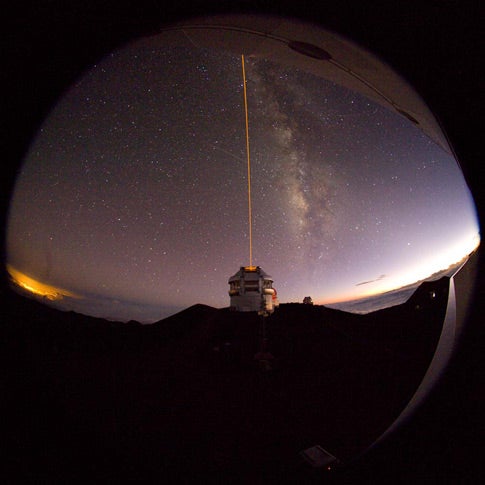Start the tour with a description of the Milky Way and our place in it. The Milky Way is a mid-sized spiral galaxy whose immense disk spans more than 100,000 light-years. Though broad, on average it’s just 3,000 light-years thick. The disk includes the graceful spiral arms that curve outward from a small bar piercing the galaxy’s center. The arms contain relatively young stars and hold the giant gas clouds that churn out new suns.
Captured through a fisheye lens, this nearly 50-second exposure simulates the naked-eye view of the telescope at night.
To help illustrate the galaxy’s basic structure, try making your own galaxy. All you need are four old CDs, a half-inch Styrofoam ball, a knife, and a hot glue gun. Start by gluing together the CDs, printed sides inward. Fill the hole in the center of your CD stack with hot glue. Then cut the Styrofoam ball in half and place one piece over the glue-filled hole on each side of the CD/galactic disk. Voilà! An instant model of the Milky Way Galaxy.
With your galactic model in hand, point out the naked-eye structure of our home spiral. Explain that the solar system sits inside the disk, about halfway out from the center (some 26,000 light-years). Because Earth lies inside the Milky Way, the spiral arms look like a band of stars that circles the sky. Here’s where the model comes in handy. Hold your makeshift galaxy low enough to look down on it. From this top-down perspective, the disk and its spiral arms come into view. If you hold the model edgewise, the galaxy appears to be a thin straight line with a bulge on either side. This line is the galaxy’s thickness, while the lumps made by the Styrofoam ball form the central bulge. In the night sky, that “lump” is in the direction of Sagittarius the Archer, who looks like a teapot.
| Fun facts |
| To Native American Seminoles, the Milky Way is the path that leads good souls to heaven. To the Norse, it’s a road leading to Valhalla, while Chinese and Arab myths represent it as a river. The name Milky Way comes from the ancient Greeks and their belief that the band was a spray of milk, or “gala,” from which the word galaxy originated.
The Milky Way’s center lies in a direction roughly 5° west-northwest of Gamma Sagittarii, the star that marks the point in the teapot’s spout. It takes 200 million years for the sun to complete one revolution around the galactic center. The last time the solar system occupied its current spot, Earth was in the age of reptiles and continental breakup. |
Sagittarius is a good place to begin scanning the summer Milky Way with the unaided eye. Here you’ll find the Large and Small Sagittarius star clouds, as well as many deep-sky binocular objects. Following the Milky Way northward leads to the Scutum Star Cloud and then into Aquila the Eagle.
At this point, a dark band called the “Great Rift” becomes obvious. It stretches from the star Deneb in Cygnus all the way to Centaurus in the southern sky. The Great Rift is an interstellar dust cloud that blocks the light from stars shining beyond it. These dust clouds are generally found on the inner edges of spiral arms; they’re also where most of the new stars are forming.
Once you’ve taken in the summer Milky Way with the naked eye, get out a pair of binoculars. A modest pair easily shows many targets. Sagittarius alone holds objects such as the Lagoon (M8), Trifid (M20), and Omega (M17) nebulae and open clusters such as M18, M21, M23, and M25.
Cygnus is another fine place to scan for Milky Way treasures. The brightest section, called the Cygnus Star Cloud, lies between the stars Beta and Gamma Cygni. The North America Nebula (NGC 7000) near the bright star Deneb is another good target, and this one even offers a chance to do a bit of geography on the side.
If you seek a binocular challenge, try the Veil Nebula (NGC 6960 and NGC 6992-5). Its faint gossamer wisps can be spotted in a pair of 7×50 binoculars.
When Galileo first pointed his modest spyglass toward the “River of Milk” in 1610, he described it as “an immense number of stars.” Views of the Milky Way’s vast and dense star clouds can have a profound effect on a curious young child. Foster that curiosity. Take your favorite youngster on a tour of the home spiral.










